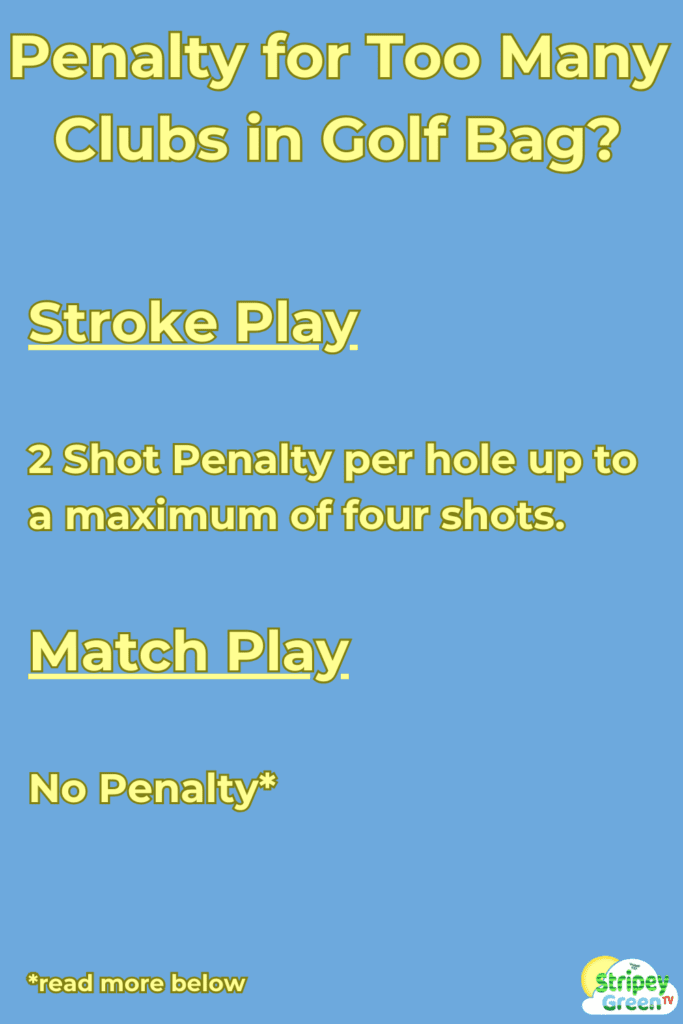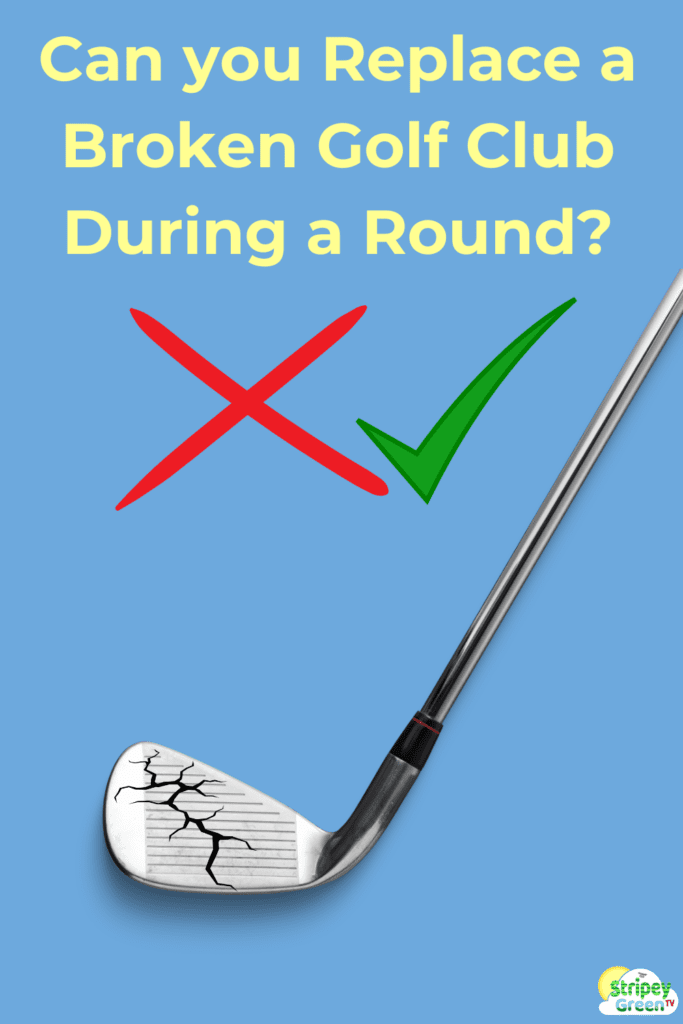How Many Golf Clubs Allowed or Needed in Your Bag?

DISCLOSURE: THIS POST MAY CONTAIN AFFILIATE LINKS, MEANING I GET A COMMISSION IF YOU DECIDE TO MAKE A PURCHASE THROUGH MY LINKS, AT NO COST TO YOU. PLEASE READ MY DISCLOSURE FOR MORE INFO.
Central to the game of golf’s essence, is the selection of the appropriate golf clubs. This is a decision that can significantly impact a player’s performance on the course.
Whether you’re a novice golfer or a seasoned professional, understanding the dynamics behind the number of golf clubs allowed or needed in your bag is crucial.
In this comprehensive exploration, we’ll navigate through the intricacies of club selection, delve into the rules governing golf clubs, and shed light on how professional and beginner golfers can optimise their golf bags to master the challenges of the course.

The Rules of Golf
Before we delve into the nuances of club selection, it’s important to establish a solid foundation by acquainting ourselves with the rules stipulated by the governing bodies of golf, namely the United States Golf Association (USGA, Rule 4.b) and the Royal and Ancient Golf Club of St. Andrews (R&A Rule Rule 4.1b(1)).
According to the Rules of Golf, each player is allowed to carry a maximum of 14 clubs in their golf bag during a round of golf. This restriction serves to ensure fairness and equity among players, preventing any unfair advantage derived from an excessive number of clubs.
Different Types of Clubs
A standard golf bag typically houses an assortment of clubs tailored to meet the varied demands of the golf course. Understanding the distinct roles and characteristics of each type of golf club is instrumental in optimising your golf bag:
- Woods: Woods are engineered to deliver long-distance shots with precision and power, making them indispensable for tee shots and long approaches from the fairway. The quintessential driver, along with fairway woods, constitutes the wood category, offering golfers the ability to cover substantial yardages with ease.
- Hybrid Clubs: Hybrid clubs are designed to combine the forgiveness and ease of use of fairway woods with the precision of irons. They are excellent for long approach shots from the fairway or rough
- Irons: Irons are renowned for their versatility, capable of executing a myriad of shots across different distances and terrains. Numbered from 1 to 9, irons encompass a spectrum ranging from long irons designed for extended distances to short irons tailored for pinpoint accuracy on approach shots.
- Wedges: Wedges are specialised clubs engineered to tackle specific challenges encountered on the golf course, such as navigating bunkers, executing delicate chip shots, or escaping from rough terrain. The arsenal of wedges includes the pitching wedge, gap wedge, sand wedge, and lob wedge, each meticulously crafted to provide golfers with the finesse and control necessary to finesse their way around the greens.
- Putters: The final piece of the puzzle, putters, assumes a pivotal role in the game, facilitating the delicate art of rolling the golf ball into the hole on the green. With precision weighting and alignment aids, putters empower golfers to hone their putting skills and achieve low scores on the scorecard. This is the most used club in the bag!
Optimising Your Golf Bag
The art of club selection extends beyond mere adherence to the 14-club limit; it encompasses a strategic approach tailored to the unique demands of each golf course and the individual playing style of the golfer. Professional golfers, in particular, epitomise this ethos, meticulously curating their golf bags to attain a competitive edge on the tour.
In stroke play, where the objective is to complete the round with the fewest strokes possible, strategic club selection assumes paramount importance. A well-rounded selection of clubs enables golfers to navigate the intricacies of the course with confidence and finesse, whether it entails unleashing the power of the driver off the tee or executing precision iron shots on approach.
Conversely, match play presents a distinct set of challenges, where each hole serves as a separate battleground. In this format, strategic flexibility reigns supreme, with golfers often opting to carry extra clubs in their bag to capitalise on specific opportunities or exploit their opponent’s weaknesses. Whether it’s wielding a versatile hybrid club to tackle unforeseen obstacles or deploying a specialised lob wedge to execute a game-changing flop shot, the ability to adapt and improvise can spell the difference between victory and defeat.
Every golfer has a different opinion of how many, and what type of club to put in the bag. Below you can see how one of the more unconventional professional golfers Bryson DeChambeau, stacks his bag.
The Role of Extra Clubs
While the rules prescribe a maximum limit of 14 clubs per bag, the question arises: Is carrying fewer clubs a viable strategy? Surprisingly, for some golfers, the answer may be yes. Streamlining your club selection to include only the essentials can promote a more focused and simplified approach to the game, minimising decision fatigue and maximising efficiency on the course.
However, the temptation to exceed the prescribed limit looms large, prompting some players to consider the inclusion of extra clubs in their golf bag. The repercussions for violating the 14-club rule can be severe.
It’s worth noting that the decision to carry extra clubs should be guided by careful consideration of the potential benefits and risks involved. While additional clubs can offer increased versatility and adaptability on the course, they also necessitate a judicious balance to avoid encumbering the golfer with unnecessary weight and complexity.
Food for thought … have you ever played a 5 club competition at your local course? Was your score much different to when you carried 14 clubs? I know mine certainly wasn’t. 🤔
What is the penalty for carrying too many golf clubs?
The consequence of carrying an excessive number of golf clubs varies depending on the style of play, whether it’s stroke play or match play.

In stroke play, where the primary aim is to complete the round with the lowest total number of strokes, the penalty for exceeding the 14-club limit is as follows:
- Each hole played with more than 14 clubs incurs a penalty of two strokes.
- Nevertheless, the maximum penalty that can be imposed is a four-stroke penalty, irrespective of the number of holes played with surplus clubs. For instance, if a player concludes their round with 15 clubs in their bag, they would face a penalty of two strokes for each of the initial two holes played with the extra club, accumulating four penalty strokes for the round.
Famously Ian Woosnam came a cropper in the 2001 Open Championship. Playing at Royal Lytham, Woosnam had just moved into a share of the lead after almost holing his tee shot on the first hole. When just about to tee off on the second hole, his caddy, Miles Byrne announced to Woosnam “There’s too many clubs in the bag.” Woosnam checked the bag and found he had 15 different clubs in his bag. Woosnam (or Byrne) had forgotten to remove the 15th club (a spare driver) from his bag after his pre-round practice session. He received a two-stroke penalty for the breach of the rule. A nervous silence was broken by Woosnam’s rant to his caddie: “God, I give you a job to do and you can’t do it.” Ultimately the excess club error cost Wossnam £218,334 in prize money and potentially his ninth appearance on the European Ryder Cup team.
In match play, where each hole represents a distinct contest, the repercussion for surpassing the 14-club threshold is less severe:
- The surplus clubs are promptly removed from the player’s bag, and no additional penalty in terms of strokes is levied.
- However, if a player refuses to discard the excess clubs upon discovery, they risk forfeiting the match.
It’s imperative for golfers to adhere to the 14-club rule to evade penalties that could adversely affect their score or match outcome. Additionally, players should periodically inspect their bags to ensure compliance with the regulation, promptly discarding any excess equipment to sidestep penalties during gameplay.
What is the Penalty for carrying less than 14 clubs in the bag?
In golf, there are no prescribed penalties for carrying fewer than 14 clubs in your bag. According to the rules established by the United States Golf Association (USGA) and the Royal and Ancient Golf Club of St. Andrews (R&A), players are permitted to carry a maximum of 14 clubs during a round of golf. However, there exists no minimum requirement regarding the number of clubs a player must carry.
Although there are no direct repercussions for carrying fewer than 14 clubs, having a reduced number of clubs in your bag can potentially hinder your performance on the course. Each club serves a distinct purpose, tailored to handle varying situations and distances. Consequently, a diminished selection of clubs may restrict your options and adaptability during play.
For instance, if you find yourself lacking a specific club that would be optimal for a particular shot, you may need to resort to using an alternative club, which could compromise your performance. Moreover, having fewer clubs may limit your ability to effectively navigate diverse course conditions.
In summary, while there are no explicit penalties for carrying fewer than 14 clubs, it is generally recommended to carry the full complement of clubs to enhance your options and optimise your performance on the golf course.
Can you replace a Damaged Club?
Yes, according to the Rules of Golf, a player is permitted to replace a damaged club during a round under certain circumstances. The Rules allow for the repair or replacement of a damaged club, provided that the damage was not caused by the player’s own actions in anger or frustration.

Here’s how the process works:
- Assessment of Damage: If a player’s club becomes damaged during the normal course of play, such as when striking a shot or making a practice swing, they are allowed to inspect the damage to determine if it affects the club’s performance.
- Extent of Damage: If the damage is deemed to significantly affect the club’s performance (e.g., a dent in the clubface or a broken shaft), the player may choose to repair the club or replace it with another club. However, the replacement club must conform to the rules regarding the number of clubs allowed in the player’s bag (i.e., no more than 14 clubs).
- Notification: It’s advisable for the player to inform their playing partners or a rules official of the damage and their intention to replace the club. This helps ensure transparency and avoids any misunderstandings during the round.
- Replacement Process: The damaged club can be replaced at any point during the round, including between holes or while play is temporarily suspended (e.g., due to inclement weather). The replacement club can be one carried by the player or borrowed from another player or caddie.
- No Penalty: Importantly, there is no penalty associated with replacing a damaged club, provided that the damage occurred through normal use of the club and was not the result of misconduct by the player.
- Damaged During a Non-Normal Course of Play: If a club is damaged due to an action outside of the normal course of play, such as throwing the club in anger, the player is not allowed to replace the club during the round. In such cases, the player must continue to use the damaged club or play without it for the remainder of the round.
While golfers are generally allowed to replace a damaged club during a round, it’s essential to ensure that the damage occurred through normal play and that the replacement club conforms to the rules. Additionally, notifying playing partners or officials of the damage and replacement helps maintain integrity and transparency during the round.
Right Clubs for Beginner Golfers
For a beginner golfer, it’s essential to start with a well-rounded selection of clubs that cater to various situations on the golf course while being forgiving and easy to use. Here’s a recommended set of clubs that beginners should consider including in their bag:
- Driver: The driver is used for long-distance shots off the tee. Look for a driver with a large clubhead and forgiveness on mishits to help beginners achieve maximum distance and accuracy. (1 of 14 clubs)
- Fairway Woods (3-wood, 5-wood): Fairway woods are versatile clubs that can be used for long shots from the fairway or off the tee on shorter holes. Beginners may find fairway woods easier to control than a driver, making them valuable additions to the bag. (2 of 14 clubs)
- Hybrid Clubs (3-hybrid, 4-hybrid): Hybrid clubs are designed to combine the forgiveness and ease of use of fairway woods with the precision of irons. They are excellent for long approach shots from the fairway or rough, offering beginners confidence and consistency. They can even be used for chipping around the green until a golfer feels more confident to use wedges. (2 of 14 clubs)
- Irons (6-iron to pitching wedge): A set of irons consisting of 6-iron through pitching wedge provides beginners with the versatility to handle a wide range of distances and lies on the course. Beginners should prioritise irons that offer forgiveness and a large sweet spot to help minimise mishits. (5 of 14 clubs)
- Sand Wedge: The sand wedge is specifically designed for shots out of bunkers and soft lies around the green. Its high loft and wide sole help beginners get the ball airborne quickly and escape from challenging situations with ease. (1 of 14 clubs)
- Putter: The putter is arguably the most critical club in a beginner’s bag, as it is used on every hole to roll the ball into the cup on the green. Beginners should choose a putter that feels comfortable and offers alignment aids to help improve accuracy and consistency. (1 of 14 clubs)
Total: 12 Clubs

There is also a strong argument to include a chipper in the bag as a golfer learns their trade. Read our article Things to Know Before Buying a Chipper to see how it could improve a beginner golfer’s game.
By starting with these essential clubs, new golfers can build a foundation for their golf game while gradually adding more specialised clubs as they progress and gain experience on the course. As a golfer progresses in skill level they will often add to, and remove from the above. Likely additions may include a second driver, utility irons and additional wedges. Different wedges will give a golfer more flexibility with approach shots and chips from around the green and in sand traps. Golfers may also add a single club to the back for specific shots. For example, if playing a golf course that’s very windy, a lower trajectory club may be swapped in.
As a golfer adds an extra club it’s important to check they still have the official maximum number of clubs (14), or less, in the bag!
It’s also important for beginners to invest in lessons or practice sessions to develop proper swing mechanics and course management skills, which will ultimately have a more significant impact on their performance than the specific clubs in their bag.
What else Should be In Your Golf Bag?
After golf clubs, there are a plethora of other items you could and should put in your golf bag. From golf balls and launch monitors to scorecard holders, you can read reviews for the other best things to stick in the bag.
Conclusion
As players embark on their journey across the fairways and greens, the 14-club limit serves as a guiding principle, shaping golfer’s decisions and influencing their approach to the game.
Whether you’re a weekend warrior seeking solace on the links, or a seasoned professional vying for glory on the tour, the question of how many golf clubs are allowed or needed in your bag is a key one.
So the next time you stand at the precipice of the tee box, surveying the undulating terrain that lies before you, remember that the true measure of a golfer lies not in the number of clubs in their bag, but in the mastery with which they wield them to conquer the challenges that await.
Bye for now!



